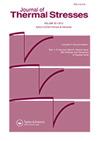Temperature-dependent models for wave velocity of oil sand
IF 2.6
3区 工程技术
Q2 MECHANICS
引用次数: 0
Abstract
AbstractKnowledge of how temperature affects the oil–sand acoustic response is useful to exploit these reservoir rocks with seismic methods. We propose three models: double-porosity coherent potential approximation (CPA), lower-bound Hashin–Shtrikmann (HS-), and contact cement (CC), based on different spatial distributions of heavy oil and temperature and frequency-dependent empirical equations. The shear modulus and S-wave velocity are affected by temperature in all the cases. Moreover, the properties of oil sands with heavy oil as a continuous matrix and higher viscosity are more sensitive to temperature. The models can provide theoretical support for the establishment of rock physical models in heavy oil reservoirs so as to quantitatively characterize the seismic response changes caused by thermal mining.Keywords: Heavy oiloil sandrock-physics modelsspatial distributiontemperaturewave response Disclosure statementThe authors declare that they have no known competing financial interests or personal relationships that could have appeared to influence the work reported in this article.Additional informationFundingThis work is supported by the National Natural Science Foundation of China (grant no. 41974123 and 42174161), the Jiangsu Province Science Fund for Distinguished Young Scholars (grant no. BK20200021) and research fund of North China University of Water Resources and Electric Power (No. 202209020).油砂波速的温度依赖模型
摘要了解温度对油砂声响应的影响对利用地震方法开发油砂储层具有重要意义。基于稠油的不同空间分布以及温度和频率相关的经验方程,我们提出了三种模型:双孔隙度相干电位近似(CPA)、下界Hashin-Shtrikmann (HS-)和接触水泥(CC)。剪切模量和横波速度均受温度的影响。此外,稠油为连续基质、粘度较高的油砂的性质对温度更为敏感。该模型可为稠油油藏岩石物理模型的建立提供理论支持,从而定量表征热采引起的地震响应变化。关键词:稠油油砂岩物理模型空间分布温度波响应披露声明作者声明,他们没有已知的竞争经济利益或个人关系可能会影响本文所报道的工作。附加信息:基金资助:国家自然科学基金(批准号:no. 91111@166.com)江苏省杰出青年科学基金项目(项目编号:41974123、42174161);BK20200021)和华北水利电力大学科研基金(202209020)。
本文章由计算机程序翻译,如有差异,请以英文原文为准。
求助全文
约1分钟内获得全文
求助全文
来源期刊

Journal of Thermal Stresses
工程技术-力学
CiteScore
5.20
自引率
7.10%
发文量
58
审稿时长
3 months
期刊介绍:
The first international journal devoted exclusively to the subject, Journal of Thermal Stresses publishes refereed articles on the theoretical and industrial applications of thermal stresses. Intended as a forum for those engaged in analytic as well as experimental research, this monthly journal includes papers on mathematical and practical applications. Emphasis is placed on new developments in thermoelasticity, thermoplasticity, and theory and applications of thermal stresses. Papers on experimental methods and on numerical methods, including finite element methods, are also published.
 求助内容:
求助内容: 应助结果提醒方式:
应助结果提醒方式:


